Summer is back and so, too, are the algae blooms that have become an unwelcome and frequent event in Lake Okeechobee and nearby estuaries. Just two short years following the "Lost Summer" of 2016, satellite imagery from the National Oceanic and Atmospheric Administration's National Ocean Service (NOAA/NOS) indicated that a bloom of blue-green algae, or cyanobacteria, was forming in Lake Okeechobee in early June. At its peak, the massive bloom covered approximately 90 percent of the lake, and large-scale blooms have been observed in the St. Lucie and Caloosahatchee estuaries, causing Governor Rick Scott to issue an emergency order in seven counties.
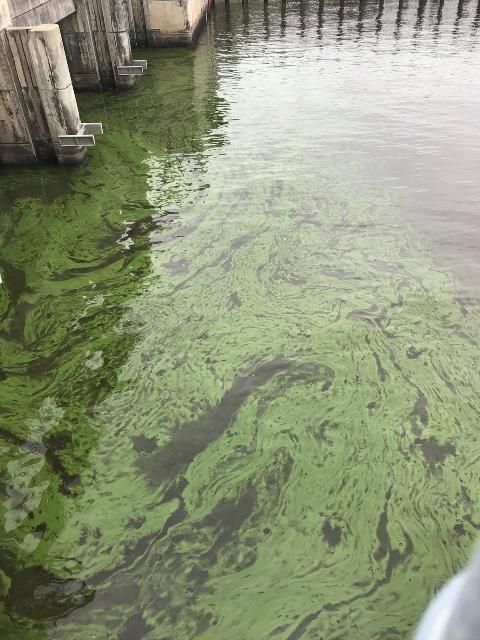
Credit: Forrest Lefler, UF/IFAS
The unknown economic and health impacts associated with these algae blooms have resulted in a concerned and sometimes confused citizenry. The well-intentioned, though sometimes misguided, messages from individuals and local advocacy groups have resulted in a chaos of mixed and sometimes questionable information, particularly on social media. The authors of this document compiled a list of frequently asked questions posted in Facebook comment feeds regarding the blooms. The purpose of this document is to address the questions with scientifically backed evidence and to advise when more research is needed.
-
Why is there a massive algae bloom this year in Lake Okeechobee?
To answer this question, we first have to provide some background about algae blooms and Lake Okeechobee. An algae bloom is the rapid and substantial increase in algae biomass in an aquatic system.
Blue-green algae, or cyanobacteria, need a few specific ingredients and conditions to grow: nutrients, most importantly nitrogen and phosphorus, and adequate sunlight.
Lake Okeechobee is a large, shallow, nutrient-enriched lake. A long history of human activities has resulted in a large reserve of nutrients in the watershed soils, wetlands and bottoms of tributaries, as well as in the sediments of the lake (Flaig and Havens 1995, Havens 2013). Increased human development around the watershed has exacerbated the nutrient problem.
The lake's shallow waters, particularly around the south and west shoreline, where light penetration is highest, provide favorable conditions for algae to grow. In addition, the lake experiences a long season of algae-growth-stimulating high water temperatures due to its subtropical location. These conditions are favorable to blue-green algae (Phlips et al. 1993; Havens et al. 1994; Paerl and Huisman 2008). As with many lakes and reservoirs in Florida and around the world, blue-green algae are common in Lake Okeechobee. Certain types of blue-green algae have special adaptations that help them dominate blooms. For example, some species have the ability to adjust their position vertically in the water column through buoyancy regulation, which allows them to find the optimal depths for light and nutrient availability. This allows cyanobacteria to bloom in the open waters of the lake where light limitation can make it difficult for other algae species (Havens et al. 2016).
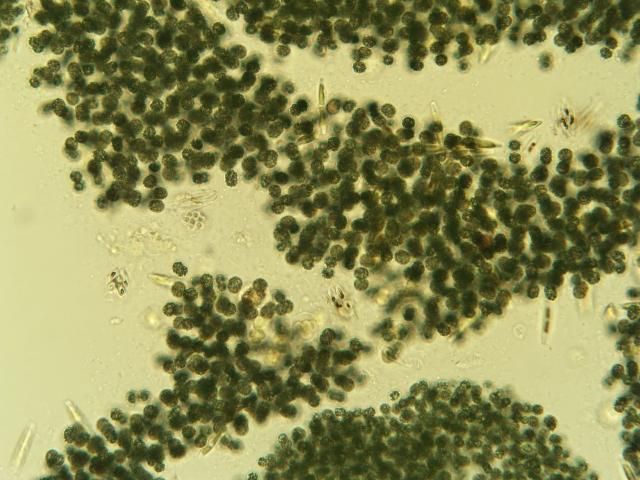
Credit: Forrest Lefler, UF/IFAS
Lake Okeechobee is most prone to having large blooms of harmful cyanobacteria when the weather is warm and sunny, typically in the spring through early fall. Periods of high rainfall can increase the potential for blooms by elevating the external flow of phosphorus- and nitrogen-rich water from the watersheds that feed the lake. Tropical storms, like Hurricane Irma, can also result in the mixing of phosphorus-rich bottom sediments, providing additional fuel for blooms.
In May 2018, a record amount of rain fell over south Florida, delivering extra nutrients from the local watershed into the lake. These nutrients added to the nutrients that had already been built up from the stormwater runoff and perhaps sediment resuspension during Hurricane Irma. This rainfall, combined with hot summer days and plenty of sunshine, created conditions that supported an intense algal bloom. June 2018 satellite images produced by NOAA show the development of a cyanobacteria bloom in Lake Okeechobee beginning in the middle of June, then intensifying and spreading to other parts of the lake.
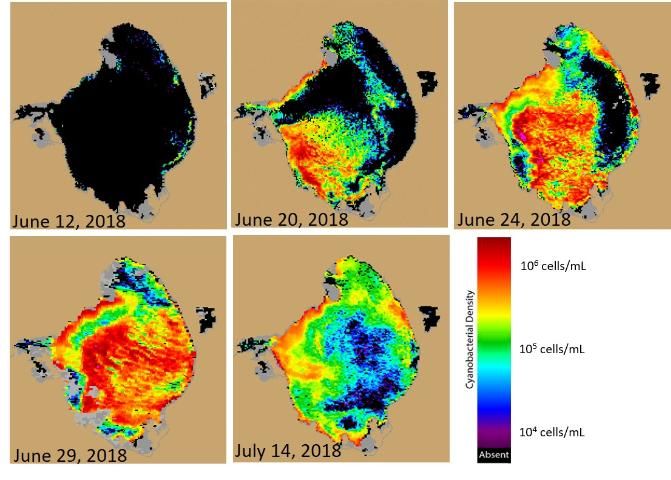
Credit: NOAA, derived from Copernicus Sentinel-3 data from EUMETSAT
2. Why are there blooms in the estuaries?
Algae blooms in estuaries are dependent on the same basic ingredients as blooms in lakes, including high nutrient levels and sufficient light availability. The SLE and CE are subject to blooms of both freshwater and saltwater algae. The conditions leading to the two types of blooms are different. Saltwater blooms typically occur when salinities in the estuaries are greater than 5 ppt. Both estuaries have sufficient nutrient inputs to support blooms, but relatively high tidal flushing rates often limit the intensity of saltwater blooms because of continuous dilution with coastal waters. For example, in the SLE the North Fork region of the estuary has the slowest flushing rates (7–14 days for 50% water turnover), allowing blooms of diatoms and dinoflagellates to build (Phlips et al. 2012), but not long enough to sustain the type of massive freshwater algae blooms observed in 2016 and 2018. Freshwater cyanobacteria blooms, such as those observed in 2016 and 2018, typically occur during periods of high rainfall, when nutrient-rich discharges of water from the watershed are large, resulting in very low salinities in the estuary. During some extreme rainfall periods, the US Army Corps of Engineers, also known as the Corps, discharge water from Lake Okeechobee into the SLE and CE as required by the Lake Okeechobee Regulation Schedule to prevent the Herbert Hoover Dike from being compromised. When an intense algal bloom is occurring in the lake, these discharges can introduce fresh water and nutrients into the estuaries, precipitating intense bloom conditions. Cyanobacteria many also be flushed out of the lake and into the estuaries, though direct evidence of this during the 2018 blooms does not exist. Refer to question 3 for further discussion.
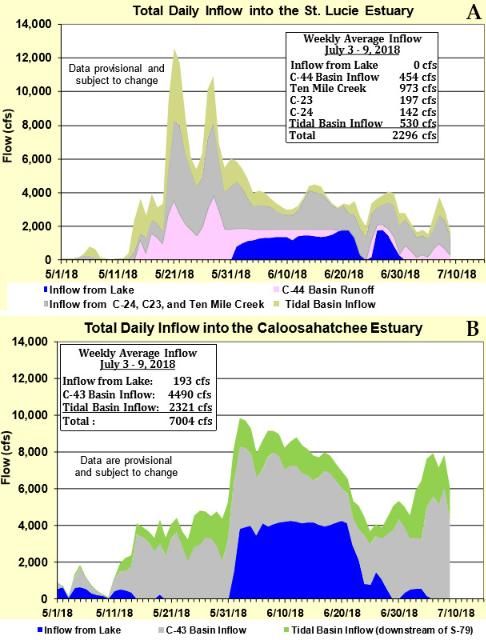
Credit: SFWMD
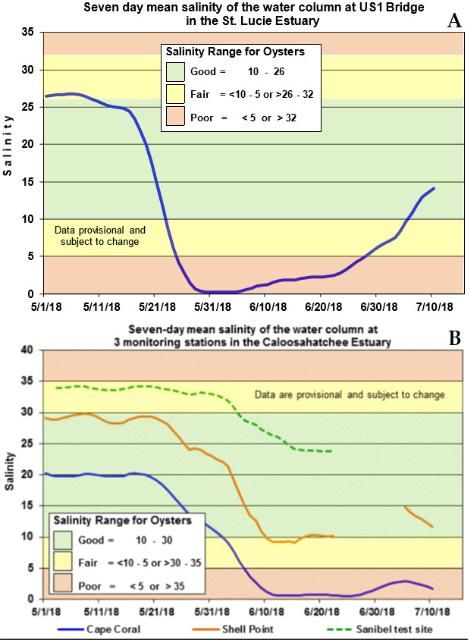
Credit: SFWMD
3. Are the algae in the estuaries from the lake?
Anecdotal and pictorial evidence of algae-bloom water flowing through the St. Lucie and Caloosahatchee canal systems has led people to speculate that Lake Okeechobee was a direct contributor to at least some of the algae blooms that have sprung up in the estuaries in 2016 and 2018.
In terms of the St. Lucie Estuary, a three-year study from 2005–2008 of algae blooms showed that the large toxic freshwater Microcystis bloom in 2005 was strongly connected to discharges from Lake Okeechobee into the South Fork region of the estuary, necessitated by very high rainfall levels (Phlips et al. 2012). Since the overall structure of the St. Lucie Estuary and Lake Okeechobee has not changed dramatically since 2005–2008, it is possible to suggest that the blue-green algae blooms of 2016 and 2018 may share at least some of the basic characteristics of the 2005 bloom. However, there appears to be insufficient scientific evidence currently available to test this hypothesis.
In 2018, most of the water that flowed into the two estuaries came from their own basins, and in the St. Lucie Estuary salinity was reduced to zero, which is favorable for blue-green blooms, before lake discharges began.
4. What kind of algae make up the blooms?
The Florida Department of Environmental Protection (DEP) has been collecting water samples at sites with visual indication of a surface water algae bloom throughout the St. Lucie and Caloosahatchee estuaries. Data from Lake Okeechobee water samples are limited to a few sites along the shoreline. The blue-green algae Microcystis aeruginosa was identified as the dominant taxon in 45 of 87 total samples collected throughout the entire region since July 17, 2018 (DEP 2018). The US Geological Survey recently conducted an independent sampling program and found two species of Microcystis, both with the potential to produce toxins. The scope and results of the research associated with the 2018 blooms in Lake Okeechobee have not yet been fully reported by the groups involved, so further details will likely be forthcoming.
5. Is the algae toxic? Is it harmful to people?
Some, though not all, blue-green algae can produce toxins. Microcystis aeruginosa, one of the dominant bloom-forming species in Lake Okeechobee, has been shown to produce the hepatotoxin microcystin, which can result in gastrointestinal problems, and, in extreme cases, liver damage, if people ingest untreated contaminated water. Impacted water sources used for human consumption are typically treated to destroy the toxin. Some blue-green algae can produce other types of toxins such as neurotoxins, which affect the nervous system and can cause respiratory distress and eye irritation. Some blue-green algae, including Microcystis aeruginosa, can cause skin irritation in a small proportion of otherwise healthy individuals. These reactions are often mild and are less of a concern than the more prominent and toxic hepatotoxins in Florida (Phlips et al. 2003; Pilotto et al. 2004).
In Florida, DEP coordinates water sampling and tests for algal species and toxicity in both freshwater and marine environments, and the Florida Department of Health takes the lead in determining if an algae bloom presents a human health risk. To avoid possible adverse symptoms and effects of exposure to toxins, humans and pets should avoid direct contact with water contaminated with intense blue-green algae blooms.
6. Why do toxin levels vary?
Concentrations of algae toxins in ecosystems are often roughly proportional to the amount of toxin-producing algae present. However, environmental conditions, including nutrient and light levels, and the age and health of algae cells can also affect toxin levels. For example, blooms of Microcystis aeruginosa frequently form surface scums that can be driven by wind onto shorelines, resulting in massive accumulations of biomass and very high, but spatially restricted, toxin levels. Methods used to collect samples for analysis can also affect the level of toxins detected. For example, monitoring efforts focusing on the collection of samples from hot spots in algae biomass accumulation can result in much higher concentrations than the average toxin levels in an ecosystem. While sampling methodology might result in overestimation of total toxin levels in ecosystems, accumulations of high levels of toxins can pose local health issues, as described in the answer to question 5.
7. Is this a wider-spread issue right now in the United States?
Algae blooms, including cyanobacteria blooms, are a growing problem not only in Florida but throughout the United States and world. Although algae blooms are naturally occurring, human activities and nutrient inputs from stormwater, agriculture, urban landscapes, and sewer and septic systems have significantly increased the amount of nutrients available for bloom formation in many environments around the world.
In addition to Florida, algae blooms have been reported this year in Utah, Lake Erie, New York, North Carolina, Oregon and as far away as New Zealand, Australia, the Philippines and the Middle Eastern country of Oman. The problem of harmful algal blooms is expected to grow with continuing increases in nutrient loads and a warmer, more extreme climate with prolonged periods of heavy rainfall and drought. This is particularly true for blooms involving cyanobacteria, which are known to favor hot weather (Havens 2018a, Havens 2018b, Paerl and Huisman 2008, and Phlips 2015).
8. What is being done to stop this from happening over and over?
The existing 2018 bloom in Lake Okeechobee could continue through the summer, although changing environmental conditions can alter the course of a bloom. Freshwater releases were temporarily stopped at the end of June. The Corps initiated releases again on July 13. Future releases of water from the lake could happen if the summer rainy season brings heavy rainfall to the watershed north of the lake.
In a longer-term context, there are numerous efforts underway to control nutrient inputs to the lake and estuaries, and to reduce harmful freshwater discharges from the lake to the estuaries. An in-depth description of all these efforts is beyond the scope of this response, so we provide a general overview of the issue and solutions.
As noted, there are two main challenges that need to be addressed to prevent the reoccurrence of lake and estuary blue-green algae blooms. First, reductions in both nitrogen and phosphorus inputs are needed in the watersheds around the lake and estuaries, as well as within lake sediments. (Havens and Frazer 2012; Paerl et al. 2016). This reduction includes direct inputs into and from Lake Okeechobee as well as inputs from lands that surround the St. Lucie and Caloosahatchee Rivers and Estuaries.
Algae blooms in Lake Okeechobee in the 1980s were the impetus for the Surface Water Improvement and Management Plan (SFWMD 1989). Certain sectors, such as agriculture, have made significant reductions in nutrient exports. Today, Lake Okeechobee, the Caloosahatchee Estuary Basin and the St. Lucie River and Estuary are all under Basin Management Action Plans (BMAPs) that provide a blueprint for reducing pollutant loadings. Even with these significant nutrient reductions, numerous challenges to reducing inputs to the lake still remain.
In fact, there has been no reduction in total nutrient loading to Lake Okeechobee since nutrient-control programs began in the 1980s. Much of the watershed soils are so saturated with phosphorus that even if all sources were stopped today, scientists estimate that the current load of residual nutrients into the lake would last more than 50 years. For this reason, the South Florida Water Management District (SFWMD) has been pursuing regional nutrient-control programs along with controls at the sources of the nutrients to stop the sources and also capture the residual legacy nutrients from soils, wetlands, and other places before they reach the lake. The watersheds around the two estuaries also have this same problem with residual nutrients in soils, wetlands, and creek bottoms.
For the lake, an additional challenge is the large accumulation of phosphorus in its sediments, which is called the internal phosphorus load. Studies indicate that the phosphorus-enriched sediments in the central region of the lake are a source of phosphorus to the water column and thus, to algae (Moore et al. 1998). Over the course of a year, the internal load of phosphorus in the lake is approximately equal to the external load. Modeling indicates that even with an immediate cessation of phosphorus inputs to the lake, internal loading from sediments would increase until the depletion of the internal phosphorus store, which would keep phosphorus concentrations high for many decades.
The second challenge that needs to be addressed is that of water quantity. Lake Okeechobee is engineered to act as a reservoir rather than a natural lake with fluid boundaries. Water levels in the lake are managed for flood control, water supply, navigation and the health of the lake's littoral zone. There are numerous existing constraints to moving the water south out of Lake Okeechobee. To reduce or eliminate excess discharges to the west and east coasts, we must complete alternative water storage and water flow projects.
9. Will the EAA reservoir help?
The Everglades Agricultural Area (EAA) reservoir is one of a number of water storage tools that will help, though not solve, the problem of algae blooms in the lake. Florida's 2017 Water Resources Law directed the expedited design and construction of the EAA reservoir. The current proposal will be designed to hold at least 240,000 acre-feet of water and include water-quality features necessary to meet state and federal water-quality standards. An acre-foot of water is the volume of water necessary to cover one acre of land, an area roughly the size of a football field, one foot deep.
The SFWMD estimates that the EAA project would reduce the number of high-flow freshwater discharges, the same that are detrimental to oyster populations, by 40 percent for the St. Lucie Estuary and 55 percent for the Caloosahatchee. It is important to note that the environmental benefits from the EAA reservoir are modeled with the assumption that all currently constructed and authorized Central Everglades Planning Project and Comprehensive Everglades Restoration Plan (CERP) projects in the area will be operational. According to the project schedule, the EAA reservoir project will be submitted for congressional authorization by December 2019.
10. Will CERP solve this problem?
The Comprehensive Everglades Restoration Plan (CERP) is a 35-plus-year plan to "restore, preserve, and protect the south Florida ecosystem while providing for other water-related needs of the region, including water supply and flood protection." The 68 project components within the plan address the quality, quantity, timing and distribution of fresh water in the natural system. There are a number of projects within CERP that will have direct impacts on Lake Okeechobee and the coastal estuaries. These are some of the ongoing and proposed projects most pertinent to the issue of freshwater discharges.
Reservoirs—In addition to the EAA reservoir, CERP includes construction of the C-43 western basin reservoir, the Indian River Lagoon-South Project, which includes the C-44 eastern basin reservoir, C-23, 24, and 25 reservoirs, and a northern Kissimmee River reservoir.
Aquifer Storage and Recovery (ASR)—ASR technology may provide the ability to store and recover large volumes of water over longer periods of time. ASR facilities inject treated and untreated groundwater, partially treated surface water, and reclaimed wastewater into the Floridan Aquifer. The water is injected in areas where the aquifer is brackish. This creates a freshwater bubble that may allow for water to be recovered and returned to the lake for use during drought years. CERP originally planned for 333 wells at 5 million gallons per day. A groundwater modeling study identified numerous constraints to ASR and the number of possible ASR wells has been modified to 130. This change greatly reduces the storage capacity of CERP compared to what originally was planned. CERP also included a system of interconnected rock quarry lakes (the Lake Belt) in southeast Florida, and those also have been dropped from the plan, meaning a further loss of regional storage.
Additional smaller-scale water storage opportunities outside of those in CERP are being implemented when available. For example, dispersed water management, or water farming, distributes shallow water across parcel landscapes such as fallow citrus land. Even with all of these water storage projects, the entirety of CERP will take decades to implement. In addition, because of the shortfall of ASR, Lake Belt and other storage, CERP is projected to fall short of the amount of water storage needed to substantially reduce estuary discharges and rehydrate the Everglades by over one million acre feet of water (NASEM 2016).
11. Are deep-injection wells a good short-term solution to stop releases of water?
Deep well injection (DWI) is the permanent disposal of water deep below the earth's surface. DWI is currently being considered as an option to use when discharges to the estuaries are necessary. Proposed use of wells would occur only when fresh water would otherwise be lost to the ocean, causing harm to the estuaries on the way. There is debate about the use of DWI because disposed water is not recoverable. Deep well injection is not a new technology, and there are currently 180 Class I wells in operation in Florida, most for wastewater disposal into the Boulder Zone. Deep injection wells alone will not entirely eliminate freshwater discharges to the estuaries. An internal SFWMD analysis of future conditions suggests that the use of 50 deep-injection wells in combination with proposed restoration projects reduces the annual volume of lake discharge by 67 percent and 77 percent for the St. Lucie and Caloosahatchee estuaries, respectively.
Additional Resources
References
Flaig, E. G., and K. E. Havens. 1995. "Historical trends in the Lake Okeechobee ecosystem I. Land use and nutrient loading." Archiv für Hydrobiologie, Monographs 107: 1–24.
Florida Department of Environmental Protection. Florida Algal Bloom Monitoring and Response. Accessed July 18, 2018. https://floridadep.gov/dear/algal-bloom/content/algal-bloom-sampling-results
Havens, K. E., C. Hanlon, and R. T. James. 1994. "Seasonal and Spatial Variation in Algal Bloom Frequencies in Lake Okeechobee, Florida, U.S.A." Lake and Reservoir Management. 10: 139–148, DOI: 10.1080/07438149409354185.
Havens, K. 2013. Deep Problems in Shallow Lakes: Why Controlling Phosphorus Inputs May Not Restore Water Quality. SGEF-128. Gainesville: University of Florida Institute of Food and Agricultural Sciences. https://edis.ifas.ufl.edu/sg128
Havens, K. E., M. V. Hoyer, and E. J. Phlips. 2016. Natural Climate Variability Can Influence Cyanobacteria Blooms in Florida Lakes and Reservoirs. SGEF-142. Gainesville: University of Florida Institute of Food and Agricultural Sciences. https://edis.ifas.ufl.edu/sg142
Havens, K. 2018a. Climate Change and the Occurrence of Harmful Microorganisms in Florida's Ocean and Coastal Waters. SGEF-216. Gainesville: University of Florida Institute of Food and Agricultural Sciences. https://edis.ifas.ufl.edu/sg136
Havens, K. 2018b. The Future of Harmful Algal Blooms in Florida Inland and Coastal Waters. TP-231. Gainesville: University of Florida Institute of Food and Agricultural Sciences. https://edis.ifas.ufl.edu/sg153.
Havens, K., and T. Frazer. 2012. Rethinking the Role of Nitrogen and Phosphorus in the Eutrophication of Aquatic Ecosystems. SGEF-190. Gainesville: University of Florida Institute of Food and Agricultural Sciences. https://edis.ifas.ufl.edu/sg118
Miller, M. A., R. M. Kudela, A. Mekebri, D. Crane, M. T. Tinker, C. S. Oates, M. Staedler, A. W. Miller, D. Hardern, and K. Ward. 2010. "Evidence for a novel marine harmful algal bloom: cyanotoxin (microcystin) transfer from land to sea otters." PLOS ONE 5 (9), e12576.
Moore, P. A., D. R. Reddy, and M. M. Fisher. 1998. Phosphorus flux between sediment and overlying water in Lake Okeechobee, Florida: Spatial and temporal variations. Journal of Environmental Quality 27: 1428–1439.
The National Academies of Sciences, Engineering and Medicine. 2016. Progress Toward Restoring the Everglades. The Sixth Biennial Review. Washington, DC: The National Academies Press.
Paerl, H. W., and J. Huisman. 2008. "Blooms like it hot." Science 320: 57–58. doi: 10.1126/science.1155398
Paerl, H. W., J. T. Scott, M. J. McCarthy, S. E. Newell, W. S. Gardner, K. E. Havens, D. K. Hoffman, S. W. Wilhelm, and W. A. Wurtsbaugh. 2016. It takes two to tango: When and where dual nutrient (N & P) reductions are needed to protect lakes and downstream ecosystems. Environmental Science & Technology 50: 10805-10813.
Phlips, E. J., S. Badylak, N. G. Nelson, and K. E. Havens. 2020. Hurricanes, El Niño and harmful algal blooms in two sub-tropical Florida estuaries: Direct and indirect impacts. Scientific Reports 10: 1910. https://doi.org/10.1038/s41598-020-58771-4
Phlips, E. J. 2015. "Phytoplankton blooms." In: M. Kennish (Ed.). Encyclopedia of Estuaries. Springer, Dordrecht, The Netherlands. Pp. 493–494. ISBN:978-94-017-8800-7.
Phlips, E. J., F. J. Aldridge, P. Hansen, P. V. Zimba, J. Ihnat, M. Conroy, and P. Ritter. 1993. Spatial and temporal variability of trophic state parameters in a shallow subtropical lake (Lake Okeechobee, Florida, USA). Archive für Hydrobiologie 128:437–458.
Phlips, E. J., E. Bledsoe, M. Cichra, and S. Badylak. 2003. "The distribution of potentially toxic cyanobacteria in Florida." In Johnson, D. and Harbison, R. D. (Eds.), Proceedings of Health Effects of Exposure to Cyanobacterial Toxins: State of the Science. St. Petersburg, FL: Florida Department of Health and the Center for Disease Control.
Phlips, E. J., S. Badylak, J. Hart, D. Haunert, J. Lockwood, H. Manley, K. O'Donnell, D. Sun, P. Viveros, and M. Yilmaz. 2012. "Climatic influences on autochthonous and allochthonous phytoplankton blooms in a subtropical estuary, St. Lucie Estuary, Florida, USA." Estuaries and Coasts 35:335–352.
Pilotto, L., P. Hobson, M. D. Burch, G. Ranmuthugala, R. Attewell, and W. Weightman. 2004. "Acute skin irritant effects of cyanobacteria (blue-green algae) in healthy volunteers." Australian and New Zealand Journal of Public Health. 28:3: 220–224.
South Florida Water Management District. 1989. Interim Lake Okeechobee Surface Water Improvement and Management Plan. West Palm Beach, FL.